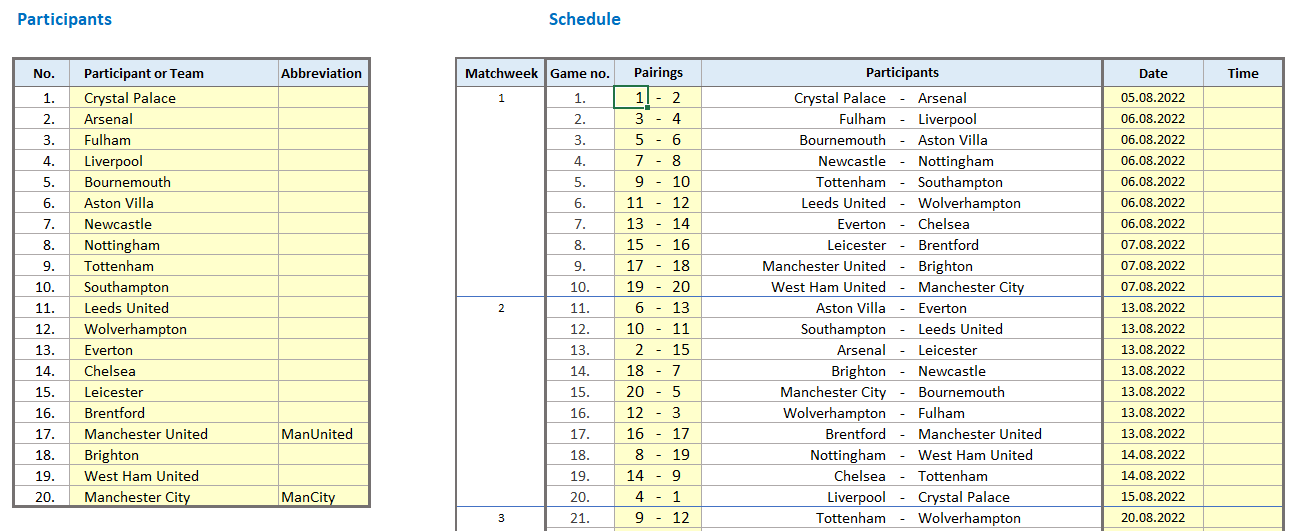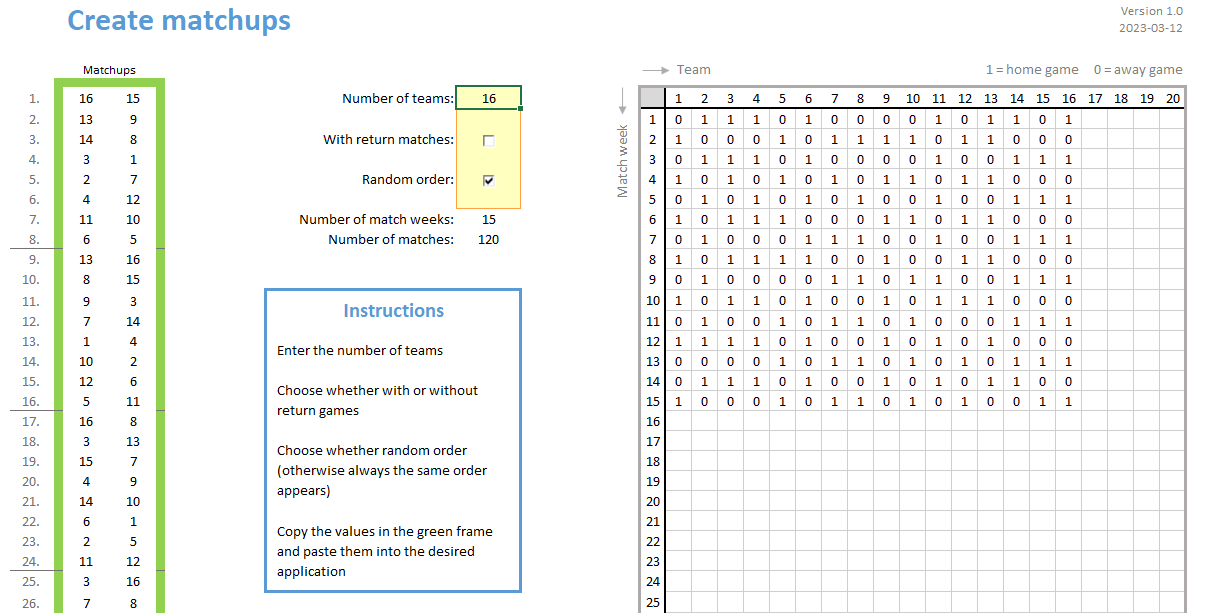

Website last updated: 2024-10-02
Match schedule for the Champions League 2024/25 ▶ see below

With this tournament schedule you can manage the Premier League or your own league.
Free download - no ads - all open and changeable - no usage restrictions
A maximum of 20 participants is possible. The overall table is automatically calculated based on the criteria of points, goal difference and goals scored. After selecting a specific match week, you can view the status of the overall table at the end of that match week.
* * *

The names of the teams are first entered on the "Plan" worksheet. The individual match pairings are created by entering the numbers of the two teams for each pairing. Matchup suggestions are on the 'Matchups' worksheet and can be copied from there. Alternatively, there is a generator for matchups programmed in VBA - see below.
Warnings appear for teams with the same name and when entering the same pairing more than once.
* * *
The match results are entered on the "Results" worksheet (▶ look at). The overall table is automatically updated immediately.
In the overall table, teams whose ranking is not clearly clarified are shown in red font. As the number of matches increases, this case becomes less and less likely. It is extremely unlikely that at the end of the season after 380 matches two teams will have the same number of points, the same goal difference and the same number of goals scored. In this exceptional case there is the possibility to clarify the ranking by entering a 'bonus point' for the preferred team.
If penalty points are imposed against a team, these can be entered to the right of the game result. For example, four penalty points are entered as -4.
The need for additional direct comparisons usually only arises when the number of participants is smaller. Then it is advisable to use the ▶ tournament schedule for a maximum of 9 participants, which also takes into account the direct comparisons of two or more teams.
* * *

You can choose between the languages German and English. In addition, however, one can add the translations of any language, so that this tournament schedule can also be adapted to any other language.
* * *
If you are planning a tournament yourself, you are faced with the problem of finding suitable pairings for the individual matches. Everyone should play against everyone. That means 66 matches with 12 participants, 120 matches with 16 participants and 190 matches with 20 participants - each without return matches.
In addition, a team should not play its sixth match until all teams have played exactly five matches. In other words: the principle of match weeks should be observed. On each match week, if the number of players is even, each team plays exactly once. If there is an odd number, one team pauses on each match week.
That's not all: After the first and second half of the season, each team should have played the same number of home and away matches, if possible half of them in the first half of the season and half in the second half of the season.
And finally: If a tournament does not consist of separate match weeks, but all matches are played one after the other, then the number of 'rest matches' between two own matches should be distributed approximately equally for all teams.
If you try to work this all out by hand for a larger number of participants (e.g. 16 participants, 120 matches without return matches), you will fail. You need a systematic approach, a so-called algorithm, which is applied by a computer program. In round-robin tournaments the circle method is often used.
This algorithm is described ▶ here in great detail and in a way that is easy to understand.
This algorithm is implemented in the following Excel file (see below for download) using the VBA programming language. If you find yourself in the embarrassment of having to generate the match pairings yourself, you can use this Excel file to automatically generate the match pairings for participants from 2 to 20 (the upper limit can be extended) - optionally with or without second legs, optionally with or without a random number generator.

The pairings generated can then be transferred from the green framed area to the tournament schedule using 'copy and paste'.
Because the file contains VBA code, it only works on Microsoft Excel.
▶ Download GeneratePairings_1.1_en.xlsm
The download is free. The Excel file can be used without restrictions. The VBA code is freely accessible and can be changed as required.
Here is a schedule for the Champions League 2024/2025.
The new version 1.2 contains not only the league phase but also the (provisional) schedule for the knockout round.
▶ ChampionsLeague_2024_25_1.2-en.xlsx (Last updated: 02.10.2024)
Current table of the league phase:
▶ https://www.uefa.com/uefachampionsleague/standings/
